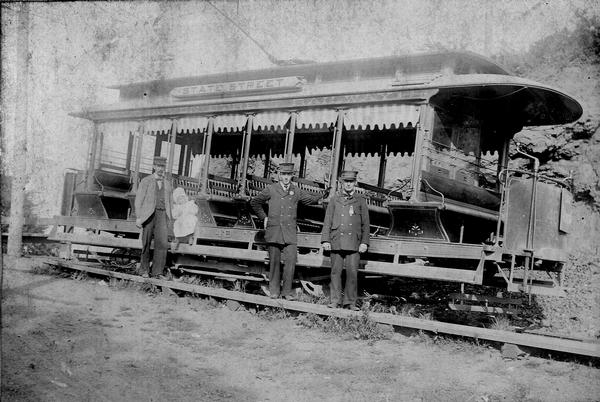
|
|
|
A Century Along the Branford Electric Railway, Part 1
On July 31st 1900, amidst no particular fanfare or ceremony, the
museum's historic line opened. Indeed, although it is presumed that the
first car left Short Beach at 6:24 that Tuesday morning, no record survives of
which specific car made this inaugural trip, or the names of those aboard.
Of those who were aboard that first car, who among them might have
dreamed that a century later the line would still be operating? Who
could have foreseen that the electric streetcar, then the most modern
of technology, would so quickly vanish from the streets of America,
that rivers of asphalt and concrete would flow across the country,
that people would one day fly above the birds, walk on the moon,
endure two World Wars, split the atom,
transmit moving and talking pictures across the globe in fractions of
a second, and that the electric streetcar would return with a new name
of ``Light Rail?´´ As the passengers on this first car traversed the East
Haven River on a spindly trestle, across whose mind would have crossed
the thought that one day a museum would exist there to preserve streetcars
and tell the story of that day, that trip?
|
This is the first in a series of articles examining a century of history
along the Branford Electric Railway. Let us begin with an overview of
the circumstances which led up to the July 31st opening of the line.
The 19th Century
The Town of Branford was first settled in 1644. Up to the about the
middle of the nineteenth century, agriculture and shipping were the
primary industries of the town. With the coming of the Industrial
Revolution, the character of Branford began to change. The Malleable
Iron Fittings Company and the Branford Lock Works were major industrial
employers that came into being after the Civil War.
The Town of East Haven was also settled in 1644, at the time still part
of the New Haven Colony. It was incorporated as a separate town in 1785.
The original boundaries of East Haven extended west to the Quinnipiac River.
Ferry service across the river to New Haven was replaced by a series of
bridges. The first, at Grand Avenue, was built in 1790 and was known as
the Grand Street Bridge. In 1797, Tomlinson's toll bridge was opened at Forbes Avenue. It remained a toll crossing until 1889. In 1855, the Grand Street
bridge had fallen into disrepair and was replaced by a new bridge at the
same location which opened in 1860. In 1876, a third bridge was constructed
at Ferry Street (the location of one of the old ferries). At
about the same time, the wooden bridge which carried
Main Street across the Farm River just west of Lake Saltonstall was
replaced with a stone arch bridge (which stands today). The debts incurred in
constructing these bridges nearly bankrupted East Haven, and
caused the town to cede its westerly portion to New Haven
in 1881. This area became known as ``The Annex´´.
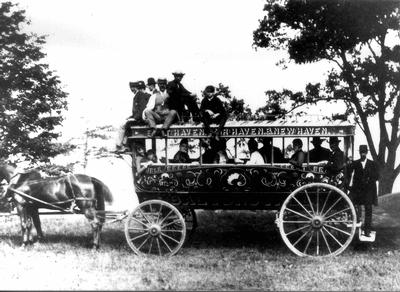 |
| Public Transportation in the 1800s: The Stage Coach |
With New Haven rising as a major center of commerce and industry, and
East Haven and Branford expanding as residential towns, the need
was increasingly being felt for an affordable, quick and convenient means
of local transportation. It was beyond the means of working families
to stable a horse. The earliest form of public transportation, dating to
the colonial days, was the stagecoach line that ran between New York and
Boston via the Boston Post Road, a route which remains largely intact today
as U.S. Route 1. The stage made a stop at Hemingway Tavern on Main
Street and Thompson Avenue (today the location of a bank).
In 1851, the railroad came to East Haven and by 1852 had reached
Branford. This provided a fast means of long-distance travel, but
service was too infrequent and expensive to be viable as a local daily
transit option.
In the days of unpaved roads, laying rail in the streets greatly improved
horse-drawn transportation. New Haven's first horsecar line ran east-west
across the center of the city, between Fair Haven and Westville, opening
in 1861.
This was long before the days when marketing firms could be paid substantial
sums to design nifty corporate names, so the line was simply known as
the Fair Haven and Westville Rail Road Company (FH&W). Later horsecar
lines included Whitney Avenue / Centerville, State Street, Sylvan
Avenue and Dixwell Avenue. Many of these original horsecar routes
can be retraced today on a Connecticut Transit bus.
Electrification of the New Haven system began in 1892, with the New Haven &
West Haven running from the center of town at Church & Chapel streets
to the amusement park at Savin Rock. This company merged in 1893 with
the Winchester Avenue Railroad, a newly-established trolley line.
The New Haven Street Railway Company was formed in 1893, merging
three horsecar lines with the new New Haven & Morris Cove trolley
which ran via the Tomlinson bridge, Forbes and Woodward Avenues to
Morris Cove and Lighthouse Point. Later in 1893, the New Haven St. Ry.
constructed a line from State & James streets, via the Ferry St. bridge,
along Farren Avenue and private right-of-way to Grannis Corners, where
it connected to the Lighthouse Point line.
The Fair Haven and Westville, the most profitable of the horse railways,
electrified its five horsecar routes
in 1894 and constructed two new electric lines.
The FH&W would acquire another electrified horsecar line, the New Haven
and Centerville, in 1897, and the New Haven St. Ry. in 1898. The Winchester
Ave. R.R. remained independent until 1901 when the FH&W gained control.
A Trolley to East Haven
During the 1800s, Lake Saltonstall was a public resort. Bathing,
boating, picnic grounds and various amusements brought crowds from
all over. In 1894 the New Haven St. Ry. built a new East Haven branch,
from Grannis Corners along
Forbes Avenue, Townsend Avenue and Main Street to the East Haven green
at Hemingway Avenue. Shortly thereafter, the line was extended
on Main Street past the north side of the Green and
turned north, running via a private right of way to the lake.
The latter portion was constructed by the Lake Saltonstall R.R. Co. in April
1894 and sold to the New Haven St. Ry. in June. The fare from East Haven
to New Haven was 10¢.
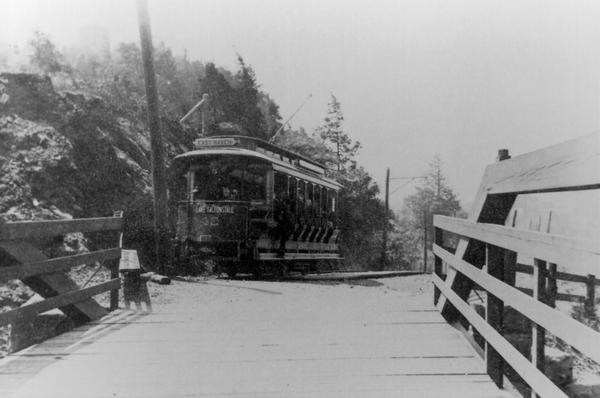 |
| Two views of New Haven Street Railway trolleys at Lake Saltonstall in 1894 |
Alas, trolley service to Lake Saltonstall was short-lived. After the 1896
season, the lake became a watershed property. Bathing and boating
activities were therefore prohibited, and Saltonstall ceased to be a
summertime attraction. In 1897, the New Haven St. Ry. accordingly changed
their routing in East Haven. Rather than running along the north side
of the Green on Main Street, cars now turned south at the Green and ran
down Hemingway Avenue. A new line to the shore resort of Momauguin was
constructed on Hemingway in 1896 by the East Haven River Railway Co. The
New Haven St. Ry. ran its cars down this route and purchased it outright
in 1898. The branch to Lake Saltonstall was abandoned.
The Branford Electric Railway
On May 12, 1897, the Branford Electric Railway Company was chartered by
means of a resolution of the Connecticut General Assembly. The text of
the charter reads (abridged with notes in italics):
Senate Joint Resolution No. 181
INCORPORATING THE BRANFORD ELECTRIC RAILWAY COMPANY
Resolved by this assembly:
SECTION 1: That A.E. Hammer, T.F. Hammer, L.J. Nichols, John Spencer,
Edmund Zacher, Richard Bradley, A.M. Young, A.O. Shepardson, A.J. Purinton,
G.G. Blakeslee, William Foote, William E. Bailey, and Charles Wilford ...
are constituted a body politic and corporate, by the name of the Branford
Electric Railway Copany, which shall be located in the town of Branford.
Said company is hereby authorized and empowered to locate, construct
and finally complete a street railway upon the route or routes hereinafter
set forth, with not more than two tracks, together with such turnouts,
switches and connections as may be necessary and convenient for full use
of same, that is to say:
Commencing at a point on Main Street in the borough of Branford, near
the power station of the Branford Electric Co., thence running westerly
through and along Main Street to a point on said Main Street where
Kirkham street intersects the same; thence through and along Kirkham
street to Maple street; thence through and along Maple street to Harbor
street; thence through and along Harbor street to the Four Corners,
so called near the Branford Point Hotel (present-day
intersection of Harbor, Stannard and Goodsell Point Road);
thence westerly through and along the highway (Stannard Avenue)
to a point near the residence of Jerome Baldwin (opposite
the east end of Old Smugglers
Road); thence across private land, passing near to the Double Beach
Hotel, to the Short Beach Road (now Route 142/Shore Drive); thence
in and along said highway, or over private land, to Short Beach; thence
partly in highway and partly on private land {the museum's right-of-way}
to the foot of Lake
Saltonstall at the Branford town line; and is hereby authorized and
empowered to construct, maintain and operate a line of railway upon
any private land of right of way which it has or may acquire near to any
of the routes mentioned herein; or to connect any such routes, or between
the termini of any said routes, or to deviate from any such route and
again re-enter same; together with the right of connecting with the
New Haven Street Railway Company by any traffic arrangement that may
be entered into between said companies.
...
SECTION 4. Said company is hereby authorized and empowered to use
electricity, or any other lawful power except steam, as a motive
power upon said railway, and may erect, maintain and use all necessary,
proper and lawful appliances for the purpose of operating said railway,
and for the proper distribution and application of the power used by it
for that purpose; and said company may purchase and hold such real estate
as may be necessary to fully carry out the objects of this
act, and may make any lawful contract with any other company or persons
with reference to the business of said company, and may collect and receive
such reasonable toll or fare from each passenger transported over said
road as the board of directors may from time to time determine.
The primary backer of and spokesperson for the new road was Alden M. Young,
a resident of Waterbury who made his summer home in the Pine Orchard
section of Branford. Mr. Young was active in developing summer shore
resort properties; this may have contributed somewhat to his interest
in the project.
The Branford Electric Railway was a local enterprise, relying on the
finances and enthusiasm of Branford residents to develop the new line.
Indeed, the New Haven Street Railway Co. felt that it could not afford
to build the line itself. Some objections were raised to the serpentine
routing of the line through Double Beach and Short Beach as opposed to
the more direct route via the Post Road (now U.S. 1). It must be remembered
that the purpose of the streetcar routes was not necessarily to provide
the fastest and most direct route, but to cover as much area as possible
so as to maximize farebox revenue. In this case, service was provided to
the developing summer resorts along the Branford shoreline. In
addition, while the shore route was longer, it avoided the rolling
hills which might have presented difficulty to the early electric cars.
Corporate Maneuvers
Prior to the formation of the Branford Electric Railway Company, the
Branford Electric Company had been chartered in 1895 as an electric and water
utility company. Their power station at Main Street and the Branford
River is referred to in the charter of the B.E.Ry.Co. On June 1, 1899,
the two companies merged as the Branford Lighting and Water Co. (BL&W).
It was under this name that the Branford Electric Railway line would
be constructed in 1900.
Between the time that the Branford line was chartered and its construction,
the route changed somewhat. The eastern terminus of the line was cut
back. Instead of running out to the power station, the line terminated
nearly 2 miles sooner at the Branford Green. When word of the company's
plans to cut the line short got out, it caused much unfavorable comment.
The line's promoter, Mr. Young, explained that the additional two miles
would add to the round-trip time and make it impossible to run on the
desired schedule. It was felt that in the future, when the line would
be double-tracked, the extension could be made to the power house.
In fact, this did not occur until a successor company extended the
line to Stony Creek in 1907.
A more significant change was at the western end. The charter called
for the line to connect with the New Haven St. Ry. at Lake
Saltonstall. As described above, this line was abandoned before
construction of the Branford line had begun.
Furthermore, the New Haven St. Ry. Company itself had ceased to exist;
Fair Haven and Westville absorbed it on October 31, 1898.
Having through service to New Haven was felt to be vital to the Branford
line's success. Given the changes in circumstances, the new plan was
to make a connection to the FH&W at the East Haven Green. The FH&W
entered into an operating agreement with BL&W in May 1900 and petitioned the
town of East Haven to make the connection at the southwest corner
of the Green, at Hemingway Avenue and New Lane (present-day River Street).
In exchange for the right to do so, East Haven pressured the
FH&W into reducing the East Haven / New Haven fare from
10¢ to 5¢.
The FH&W would now operate the new Branford Electric Railway and
provide cars, crews and power. The BL&W Co. was responsible for
construction and upkeep of the line itself. FH&W crews collected
fares and both companies shared the net profits.
Although BL&W had its own power plant in Branford,
the D.C. traction power was not supplied by them. It was
tapped from the existing East Haven / Momauguin line, ultimately originating
at the FH&W substation ``B´´ in New Haven.
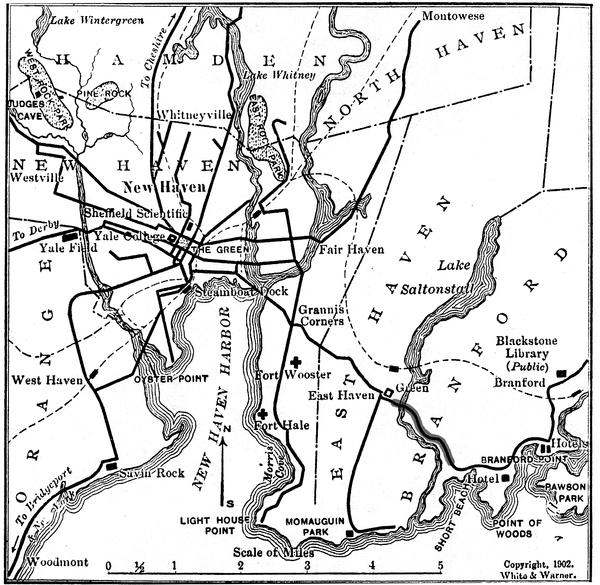 |
| A 1902 map of the New Haven trolley system shows the Branford Electric Railway running between East Haven and Branford. The portion which is preserved and operated by the Shore Line Trolley Museum is shaded |
The Construction
Construction of the line began in April of 1900. A. William Sperry was
the surveyor and engineer, and Chas. Wingate was the Superintendent of
Construction. Mr. Sperry rented a cottage in Brockett's Point for the summer
from which to supervise the project.
The promoter of the line, A.M. Young, promised it would
open about May 20th (he was off by a few months).
New England Engineering Co. was the major contractor, with a substantial
subcontract to Charles W. Blakeslee and Sons of New Haven. The latter
company was also employed nearly fifty years later to rip out much of the
trolley trackage in New Haven, and a successor company is still
in business today. M.P. Rice contracted to fill in the
low-lying marsh areas and to lay out the
railroad ties along the line. Frank Beach and Robert Ford had the contract
for setting the line poles. Trolley wire was hung starting on July 5,
using a line car powered by the very wire it was stringing.
The construction of the line was fairly uneventful although many minor
unforeseen delays were encountered. Blasting was required at some
points on the Branford end and a bridge was required to cross
the tracks of the New Haven R.R at Maple Street. The portion of
the route which is now the museum's railway was easier to construct
and was substantially complete by Sunday July 8th, when an
inspection trip was made between East Haven and Short Beach.
The Opening
The date of July 31st which now has such significance was but a stepping
stone towards the opening of the complete line. On this date, trolleys
first began regular scheduled passenger operation between East Haven
and Short Beach. The New Haven Journal-Courier reported:
TO SHORT BEACH TODAY
Trolley Cars Will Run Every Twenty-four Minutes
to That Popular Resort.
The Branford Electric Railway company (sic) will open the new
schedule between East Haven and Short Beach this morning, the first car
leaving Short Beach at 6:24.
Until completion of road cars will run between Short Beach and East Haven
every twenty-four minutes, connecting at East Haven with the through
cars of the Fair Haven and Westville railroad running between Yale
Field and Momauguin.
These cars leave the corner of State and Chapel streets commencing at
6:06 a. m. and will run every twenty-four minutes until 10:30 p. m.
*5:48 a. m. (barn), *6:06, *6:30, 6:54,
7:18, 7:42, 8:06, 8:30, 8:54, 9:18, 9:42, 10:06,
10:30, 10:54, 11:18, 11:42, 12:06 p. m., 12:30, 12:54,
1:18, 1:42, 2:06, 2:30, 2:54, 3:18, 3:42, 4:06, 4:30,
4:54, 5:18, 5:42, 6:06, 6:30, 6:54, 7:18, 7:42, 8:06,
8:30, 8:54, 9:18, 9:42, 10:06, 10:30. *Except Sunday
The cars leave Short Beach for New Haven as follows:
6 a. m. (Monday only), *6:24, *6:48, *7:12, 7:36, 8, 8:24,
8:48, 9:12, 9:36, 10, 10:24, 10:48, 11:12, 11:36, 12 m.; 12:24 p.m.,
12:48, 1:12, 1:36, 2, 2:24, 2:48, 3:12, 3:36, 4, 4:24, 4:48,
5:12, 5:36, 6, 6:24, 6:48, 7:12, 7:36, 8, 8:24, 8:48, 9:12, 9:36,
10, 10:24, 10:48, 11:12. *Except Sunday.
The fare will be fifteen cents between this city (New Haven)
and Short Beach and twenty cents will be the fare to Branford
on completion of the road.
The road will be equipped with six new cars in the fall for winter use
and each will be forty feet in length. They will be finished in
mahogany and will be of the latest patent and finish. The windows
will be of plate glass.
With Short Beach service open, work was proceeding rapidly to finish
up the remaining
2.8 miles to Branford. As of August 17, cars ran nightly as far as the
railroad bridge at Maple Street;
during the day the work crews owned the road. Finally, on
August 25th service was opened to the end of the line.
At this time, there was no through service to New Haven. Passengers
had to transfer at the East Haven Green to a New Haven car.
Double-tracking of the East Haven / Momauguin line was underway, and
there was no reason to install the switchwork to connect with
the Branford branch only to tear it up again. Service to Branford
was made with six FH&W single-truck cars which were brought in
via a temporary track connection at the East Haven Green. The permanent
double-track turnout was completed and open for New Haven / Branford
through traffic near Labor Day 1900
(newspaper accounts differ on the exact date).
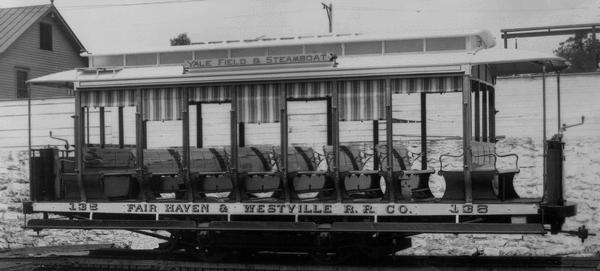 |
| Single-truck open trolleys similar to Fair Haven and Westville no. 138 provided service when the Branford Electric Railway opened on July 31 1900 |
In our next installment: Boom times on the Branford Electric Railway!, the
first new cars arrive, the wreck of 1902, double-tracking and the
coming of Consolidated.
Much gratitude is owed to James West who shared the notes that he and
the late Dick Fletcher collected in researching their book,
Along Branford Shore.
The book, a more comprehensive look at the heyday of the Branford line,
is available through the museum book store.
Additional thanks to Prof. George
Baehr for his accounting of the New Haven street railway system.


